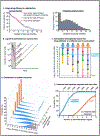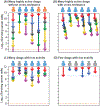Drug independence and the curability of cancer by combination chemotherapy
- PMID: 35842290
- PMCID: PMC9588605
- DOI: 10.1016/j.trecan.2022.06.009
Drug independence and the curability of cancer by combination chemotherapy
Abstract
Combination chemotherapy can cure certain leukemias and lymphomas, but most solid cancers are only curable at early stages. We review quantitative principles that explain the benefits of combining independently active cancer therapies in both settings. Understanding the mechanistic principles underlying curative treatments, including those developed many decades ago, is valuable for improving future combination therapies. We discuss contemporary evidence for long-established but currently neglected ideas of how combination therapy overcomes tumor heterogeneity. We show that a unified model of interpatient and intratumor heterogeneity describes historical progress in the treatment of pediatric acute lymphocytic leukemia (ALL), in which increasingly intensive combination regimens ultimately achieved high cure rates. We also describe three distinct aspects of drug independence that apply at different biological scales. The ability of these principles to quantitatively explain curative regimens suggests that supra-additive (synergistic) drug interactions are not required for successful combination therapy.
Keywords: combination therapy; drug independence; tumor heterogeneity.
Copyright © 2022 The Authors. Published by Elsevier Inc. All rights reserved.
Conflict of interest statement
Declaration of interests A.C.P. is a consultant for Merck. E.V.S. is an employee and stockholder of Merck Sharp & Dohme Corp., a subsidiary of Merck & Co., Inc., Kenilworth, NJ, USA. P.K.S. is a member of the SAB or BOD of Applied Biomath, RareCyte Inc., and Glencoe Software, which distributes a commercial version of the OMERO database; P.K.S. is also a member of the NanoString SAB and consultant for Merck and Montai Health. In the last 5 years the Sorger lab has received research funding from Novartis and Merck, and the Palmer lab has received research funding from Prelude Therapeutics. P.K.S. and A.C.P. declare that none of their commercial relationships has influenced the content of this manuscript. A.E.P. declares no conflict of interests.
Figures



References
-
- Bast RC Holland-Frei cancer medicine, 9th edition.
-
- Lészló J (1995) The Cure of Childhood Leukemia: Into the Age of Miracles, Rutgers University Press.
-
- Frei E and Freireich E (1965) Progress and Perspectives in the Chemotherapy of Acute Leukemia. In Advances in Chemotherapy: Volume 2 (Goldin A et al., eds), Academic Press - PubMed
Publication types
MeSH terms
Grants and funding
LinkOut - more resources
Full Text Sources
Other Literature Sources
Medical

